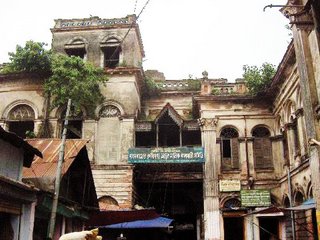
Mill Barrack at Sutrapur, Dhaka:- The sugar mill built ran into financial loss and it was turm over to a flour mill owner. In 1857, the barrack of the mill was used by the British troops brought from Calcutta to quell the mutineers at Dhaka. Many of the mutineers- 'Sepoy Mutiny of 1857' (first freedom movement of the subcontinent) of Lalbagh Fort were detained here for trial. Between 1903 to 1912 a police training school sub-inspector cadets and constables was established. Now a fully developed training school for traffic police is running there (photo British Library: early 20th century).
Dhaka’s old Mansions:
In Dhaka, a thriving settlement had began before the Mughals made it the capital of Bengal. The French merchants came to Dhaka in the 1680s and settled in Tejgaon. They established Farashganj as a trading quarter to conduct business with permission from Naib Nazim Nawajesh Khan in 1740. Mr. Pogose, an Armenian businessman and philanthropist, took lease of the area from the English. The Hindu Zamindar mansions are dispersed on and around Tipu Sultan Road, Narinda, Farashganj and Sutrapur. The mile long Farashganj Road running East-West, starting from 'Sutrapur' up to the North Brook Hall (Lal Kuthi), once a treasure for traditional architecture, is now the centre of vegetable, spice, timber and cement wholesalers. It is full of derelict and abandoned palatial mansions of Hindu Zamindars, many of which are over 150 years old.

Ruplal house - late 19th cenury
late 19th century bldg
Ruplal House: Early 19th century mansion, erected jointly by Ruplal and Ragunath - on the Buckland Bund in Farashganj that once presented as a grand river front. It’s two-story and divided into two unequal blocks. The building contains over fifty rooms of various sizes including a number of spacious halls. In 1888, when Lord Dufferin, the Viceroy of India visited Dhaka, a Ball was arranged in his honour in the Dance Hall of this mansion. At present, this massive old building is heavily encroached by spice and vegetable vendors and a colony of unauthorized squatters. This mansion vied with the majestic Ahsan Manzil in splendour.
Rose Garden: The building popularly known as the ‘Rose Garden’ in Old Dhaka is not a garden of roses, but in reality it was a pleasure lodge, built by a Hindu zamindar 'Hrikesh Das' in the late 19th century at Narinda quarter of Old Dhaka. The building has elegant Corinthian columns. Originally there was a fountain, the structure of which still remains. The garden has several classical marble statues. This tall, massive building is in good condition and stands proudly reaching the skyline of old Dhaka.
Rebati Bhavan: Situated in the Sutrapur area of Old Dhaka on Rebati Mohan Das Road, the Sutrapur Zamindar 's mansion was constructed on a one acre land by an Hindu landlord 'Rebati Mohan Das' in the early 20th century. The building contains about thirty-five rooms of varying dimensions. There is another three-storied block on its northern side. It is said, after the demise of Rebati Mohon Das, his elder son Satyendra Kumar Das, retained the ancestral Rebati Bhavan, while his younger son Hemendra Kumar Das constructed the new house on the north. This new house was named Das Lodge that contains about the same number of rooms.
Bhajohari lodge in Tipu Sultan Road

Colonial tenament house of early 20th century






2 comments:
thanks for sharing the knowledge..........it is highly appritiateble.......i am a student of engineering.....i have visited more then 20 countries of the world...icluding europe and australia,usa....etc.....but i find dhaka as the most soothing to my eyes....apart all the problems id has....thanks again.....please try to include more places here with description.....such as modhur canteen, shakhari bazar, nawab barir pukur, the tank in front of victoria perk.......etc
Mr Ershad I am a recently graduated Architect and these photos and facts makes my hair stand....thank you very much sir for doing a job that is truly priceless.
Md.Rezwanur rahman
Post a Comment